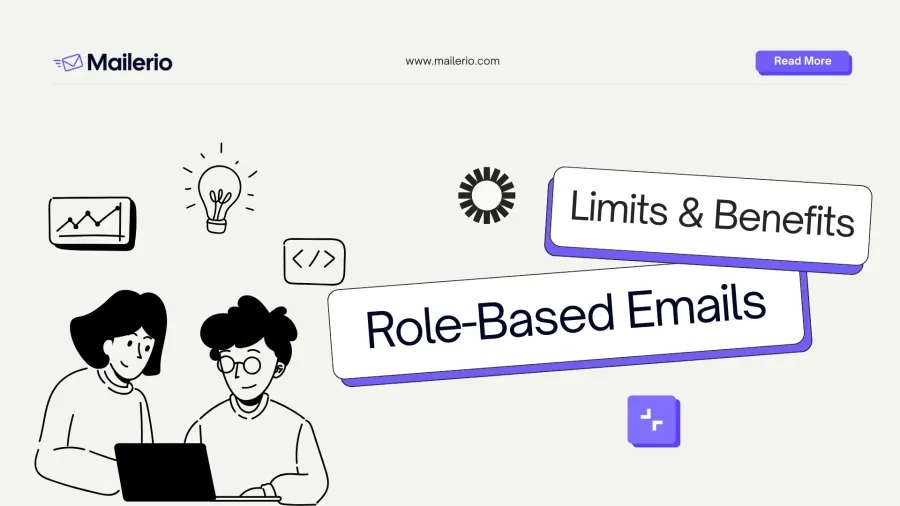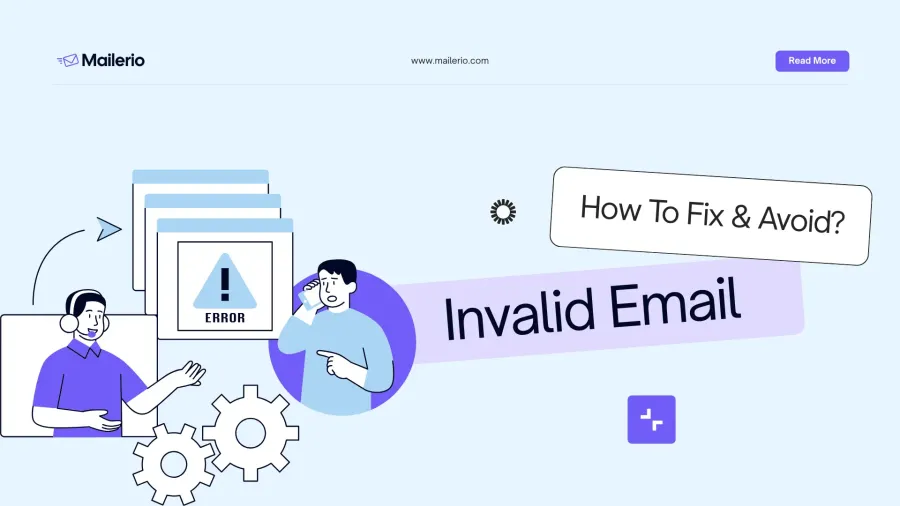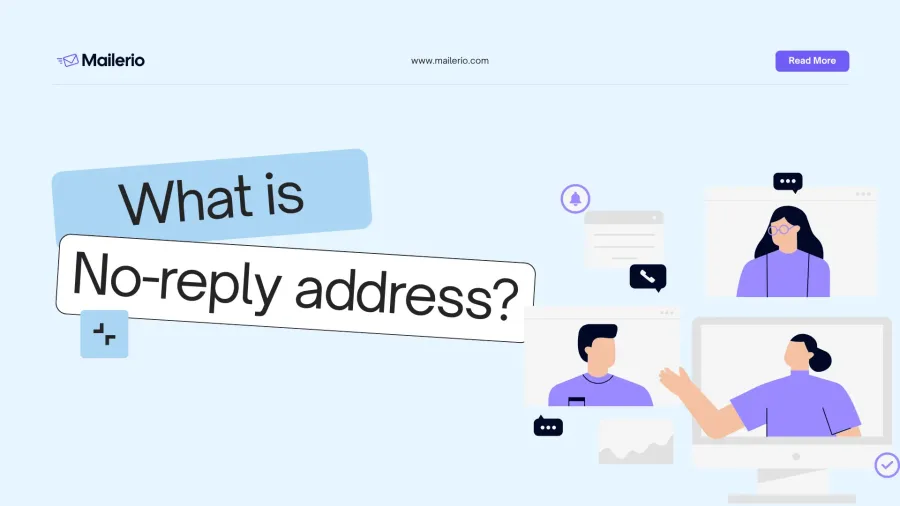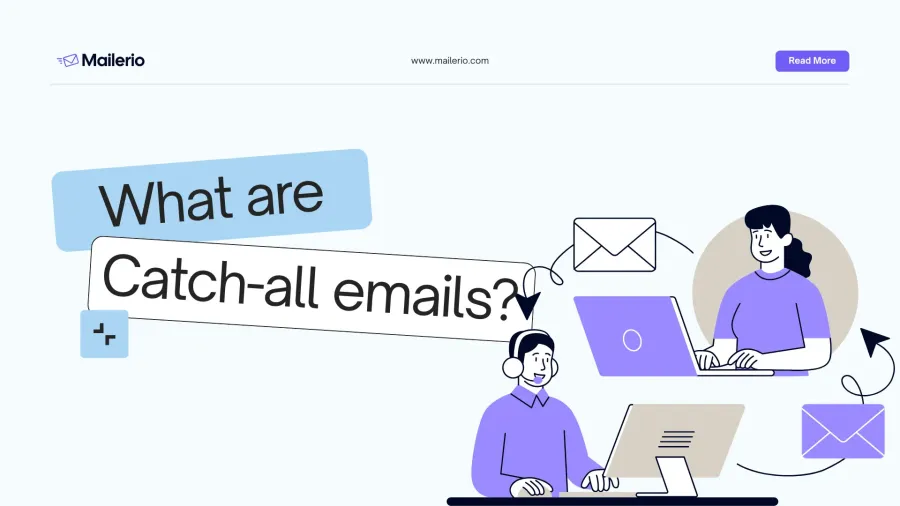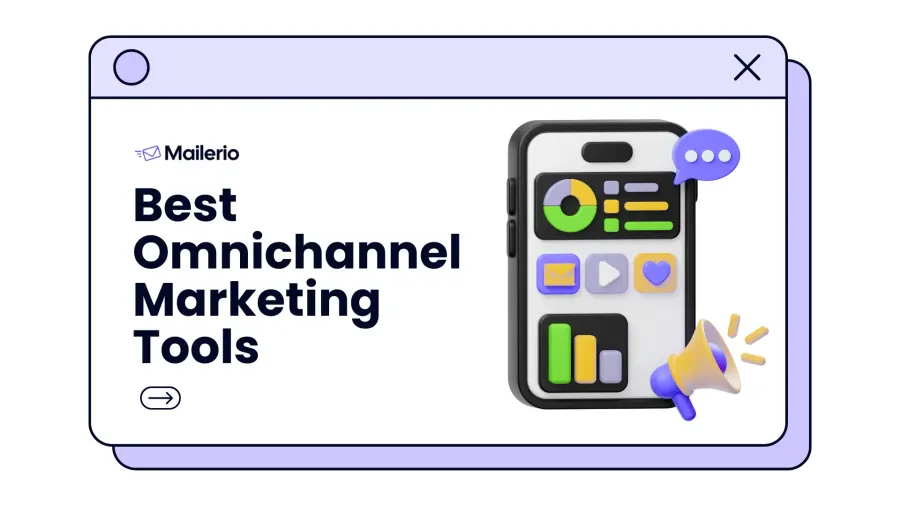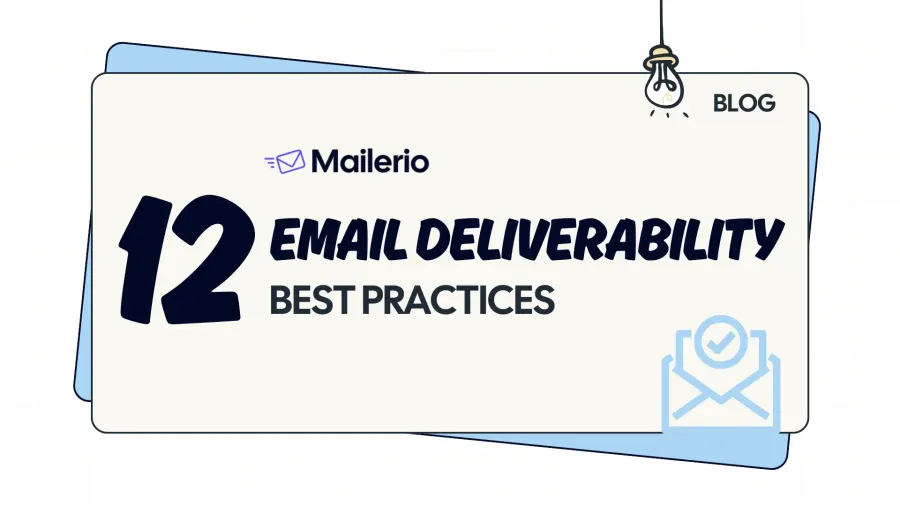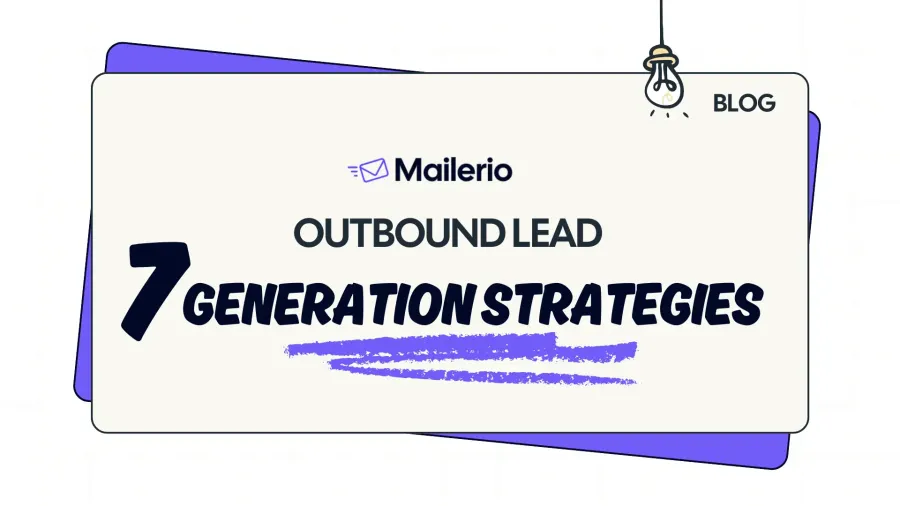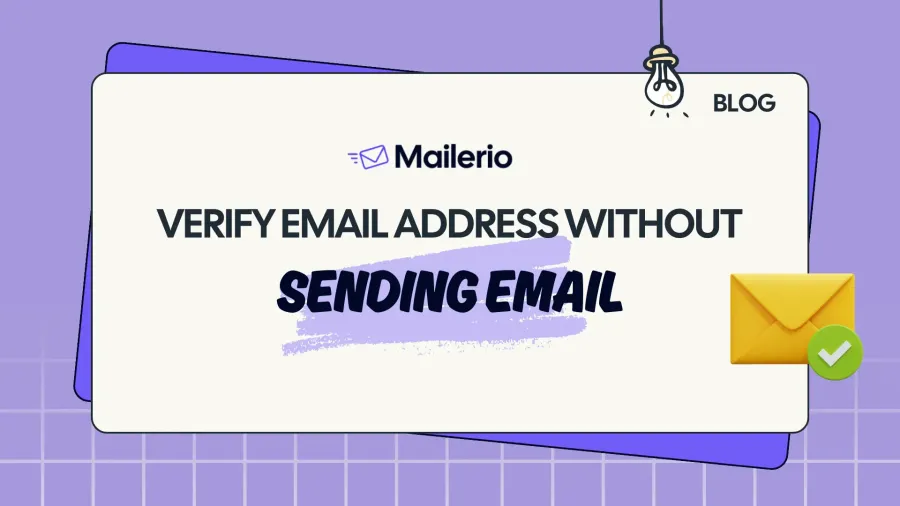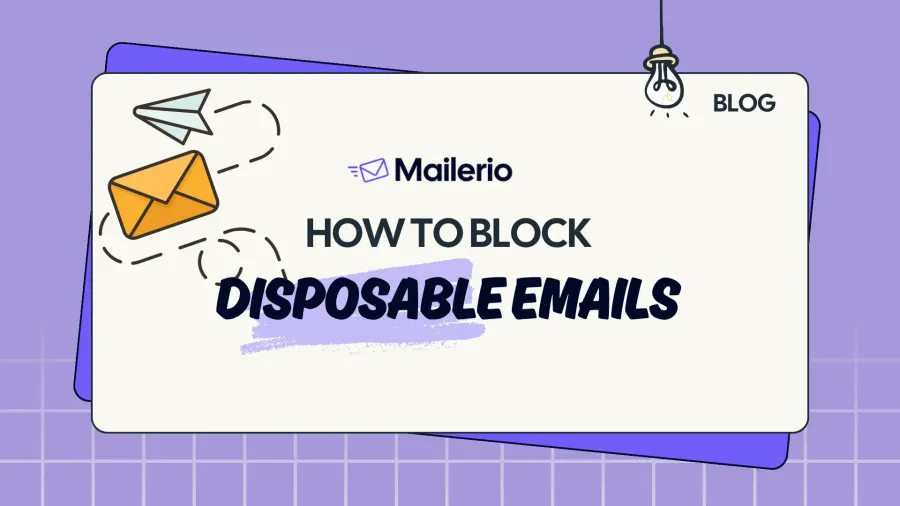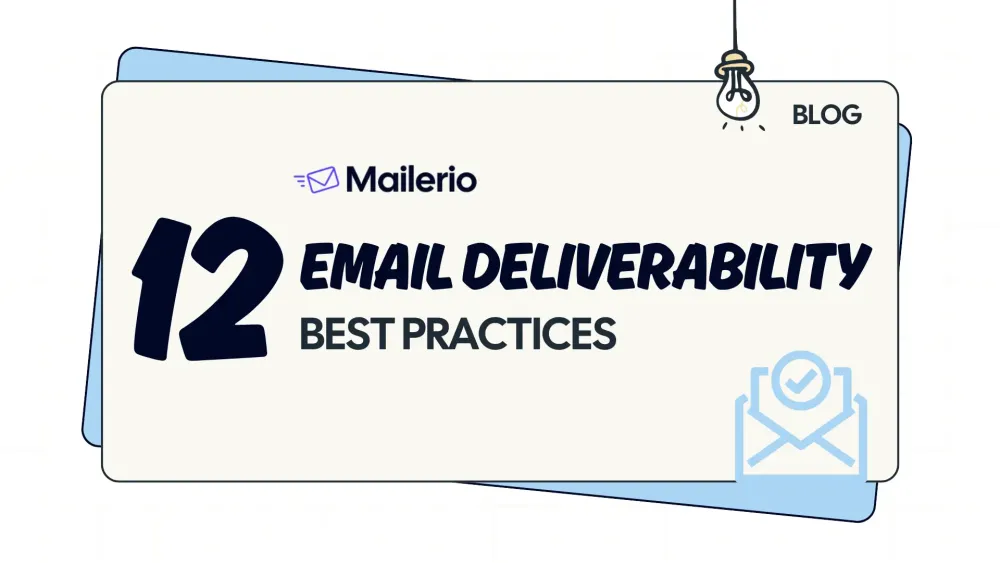
Struggling with email marketing can feel like battling an invisible enemy. Despite your best efforts, emails may not even reach your audience, undermining your strategy. Recent data highlights a challenge: while overall deliverability rates improved to about 96.4% in 2023, achieving consistent inbox placement is still a struggle for many businesses.
Table of Contents:
- What Is Email Deliverability & Why Does It Matter?
- How to Check Your Email Deliverability
- Key Email Deliverability Metrics
- 12 Best Practices to Improve Email Deliverability
- Authenticate with SPF DKIM DMARC (and BIMI)
- Clean and Validate Your Email Lists Regularly
- Monitor and Manage Sender Reputation
- Maintain List Hygiene and Engagement
- Optimize Sending Practices
- Craft Relevant Non-Spammy Email Content
- Make Unsubscribe Simple and Visible
- Use Pre-Send Audits and Testing
- Protect Data Privacy and Compliance
- Employ Feedback Loops and Monitor Spam Complaints
- Regularly Run Deliverability Audits
- Leverage Automation But Avoid Common Pitfalls
- How to Conduct an Email Deliverability Audit (Step-by-Step)
- Troubleshooting Guide: Common Deliverability Problems & Solutions
- Real-Life Success Stories: Overcoming Email Deliverability Challenges
- Top 8 Email Deliverability Services (Comparison)
- FAQ
- Wrap Up
By understanding and implementing key email deliverability best practices, you can boost your campaign performance. In this guide, we’ll explore practical strategies to optimize your email deliverability, leveraging tools like Mailerio to maximize ROI.
TL;DR
Email deliverability measures whether your emails actually land in recipients’ inboxes, not just whether they’re sent. High deliverability boosts engagement, ROI, and sender reputation. Key factors affecting it include sender reputation, email authentication (SPF, DKIM, DMARC, BIMI), list hygiene, content quality, sending practices, and engagement metrics.
What Is Email Deliverability?
Email deliverability is the measure of how successfully your emails reach your recipients’ inboxes (not just their mail servers). It goes beyond whether your email was “sent” it’s about whether it avoids spam folders, gets past filters, and actually lands where your audience will see it.
Why care? High deliverability directly impacts engagement, ROI, and maintains a good sender reputation. With current inbox-placement rates soaring to the mid-90% range, ensuring your emails land where they should be is crucial for maximizing returns and staying compliant with regulations.
Factors That Affect Email Deliverability:
- Sender Reputation: ISPs (like Gmail, Outlook, Yahoo) track whether your emails get opened, ignored, or marked as spam.
- Email Authentication: Proper setup of SPF, DKIM, and DMARC signals to ISPs that your emails are legitimate.
- List Hygiene: Sending to valid, engaged subscribers improves reputation; sending to invalid or unengaged addresses hurts it. This is where Mailerio email validation service comes in handy.
- Content Quality: Spammy wording, misleading subject lines, or poor HTML practices can trigger filters.
- Sending Infrastructure: Whether you’re using a trusted ESP (email service provider), dedicated IP, or shared IP pool affects deliverability.
- Engagement Metrics: High opens, clicks, and replies tell ISPs your emails are wanted.
Interestingly, there’s been a 44% drop in spam classification rates from 2020 to 2023 (Selzy: Industry Spam Rates), highlighting how important effective email practices have become. With improved strategies, more of your emails can successfully reach their intended targets, making deliverability a central part of your marketing efforts nevertheless whether you use multi-channel or omnichannel marketing.
Make Sure Your Emails Land in Inbox!
Validate Email Lists To Protect Your Sender Reputation
Email Deliverability vs Email Delivery
Email delivery is whether an email is successfully accepted by the recipient’s mail server (i.e., it didn’t bounce). Email deliverability is about whether that accepted email actually makes it into the recipient’s inbox instead of going to spam, junk, or being filtered out. Here’s a visual for better clarity:
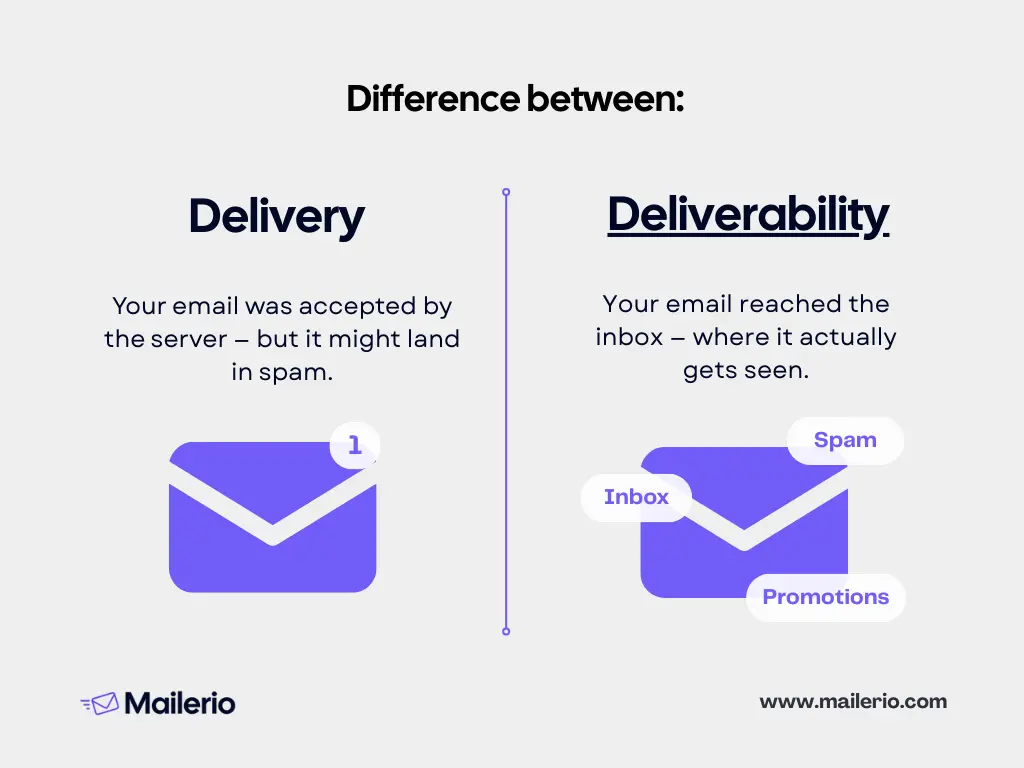

In short:
- Delivery = Did it get there? (server acceptance)
- Deliverability = Where did it land? (inbox vs spam vs junk)
| Email delivery | Email deliverability |
|---|---|
| Successful server transmission | Targets inbox placement |
| Watch for high bounce rates to indicate issues | Influenced by sender reputation and engagement rates |
| Ensure mail server configuration is correct | Avoid spammy content to improve placement |
12 Best Practices: How To Improve Email Deliverability
Getting your emails accepted by mail servers is only half the battle, the real challenge is ensuring they land in the inbox where your audience can actually read them. Internet service providers (ISPs) use complex filters and reputation scores to decide which emails deserve inbox placement and which should be sent to spam. Let’s take a look at best email deliverability practices to make sure your emails land in inbox:
- Authenticate your emails
- Maintain a clean email list
- Monitor and manage sender reputation
- Maintain list hygiene and engagement
- Optimize sending practices
- Write relevant, non-spammy content
- Provide a clear unsubscribe option
- Warm up your IP/Domain
- Use pre-send audits and testing
- Protect data privacy and compliance
- Employ feedback loops and monitor spam complaints
- Regularly run deliverability audits
- Leverage automation but avoid common pitfalls
1. Authenticate with SPF, DKIM, DMARC, and BIMI
Getting your emails authenticated is crucial. This ensures that internet service providers recognize your emails as legitimate, massively improving your chances of landing in the inbox, not the spam folder. Setting up SPF, DKIM, and DMARC forms a solid foundation.
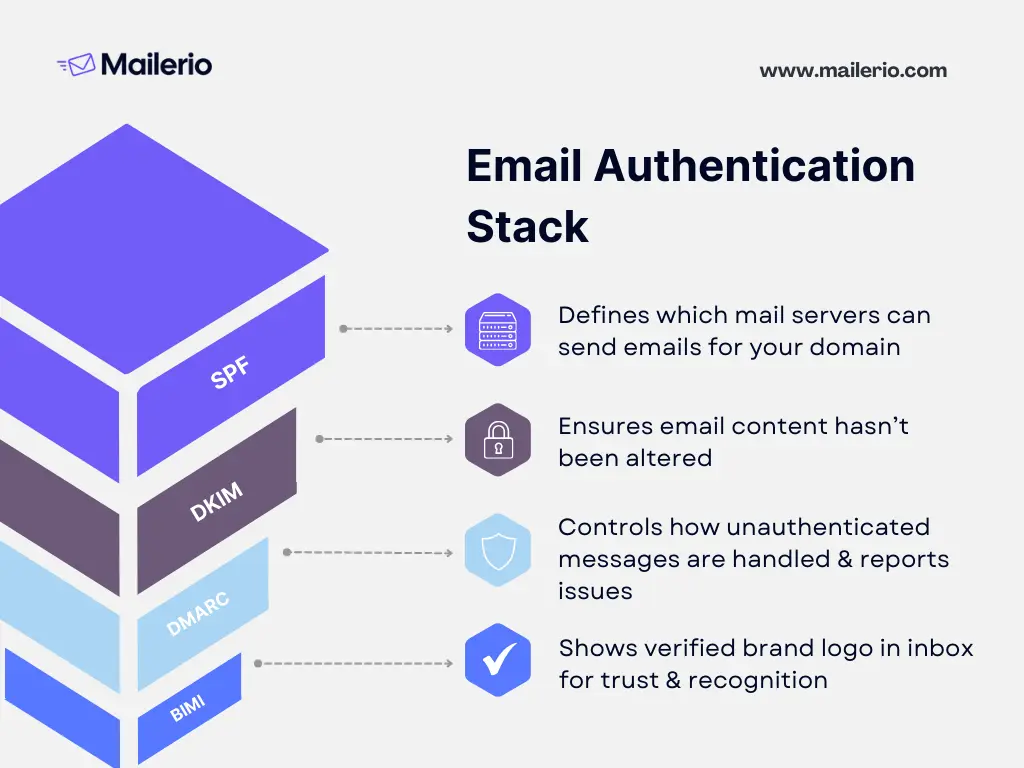

- SPF (Sender Policy Framework): Defines which mail servers are authorized to send email on behalf of your domain.
- DKIM (DomainKeys Identified Mail): Uses an encrypted signature to verify that your email content hasn’t been altered in transit.
- DMARC (Domain-based Message Authentication, Reporting & Conformance): Builds on SPF and DKIM, giving you control over how unauthenticated messages are handled, while providing detailed reporting.
- BIMI (Brand Indicators for Message Identification): Displays your verified brand logo next to authenticated emails, reinforcing trust and improving recognition.
Regularly auditing these settings helps maintain your sender reputation and consistently yields better inbox results. In case you need email deliverability services, you can always get in touch with our team.
2. Clean and Validate Your Email Lists Regularly
Maintaining a healthy email list is crucial for strong deliverability. Sending to invalid, inactive, or unengaged addresses can harm your sender reputation and trigger spam filters.
- Remove Invalid Emails: Regularly eliminate addresses that bounce or produce errors to prevent deliverability issues.
- Prune Inactive Subscribers: Identify contacts who haven’t engaged in months and consider re-engagement campaigns or removal.
- Use List Validation Tools: Employ automated services to check for typos, role-based addresses (like info@ or admin@), and disposable emails. You can do that with Mailerio using free trial.
- Segment Based on Engagement: Focus your campaigns on active, interested subscribers to maximize opens, clicks, and overall engagement.
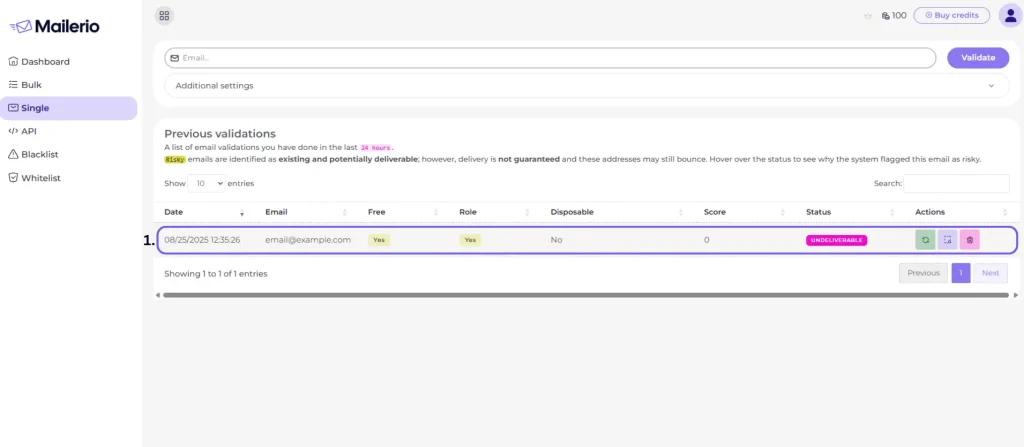

Keep those lists spotless. Implement a double opt-in process, steer clear of purchased lists, and automate cleaning whenever possible. Tools like Mailerio can speed up this process with bulk checking and API integrations. Research suggests that effective list hygiene significantly reduces bounce rates, improving overall deliverability.
3. Monitor and Manage Sender Reputation
Your sender reputation is like your credit score for emails. Warm up new domains or IPs slowly, maintain a consistent sending volume, and use suppression lists. Regular audits and removing risky addresses are key strategies to keep your inbox placement rates above 95%, backed by ESP benchmark reports. To maintain and improve your sender reputation, consider these steps:
- Use Email Validation Tools: Regularly clean your email lists with tools like Mailerio to minimize bounce rates. Email validation ensures you’re contacting real, active email addresses, which enhances your sender score.
- Track Engagement Rates: Pay attention to open rates, click-through rates, and unsubscribe rates. Low engagement can signal to ISPs that your emails aren’t relevant, negatively impacting your reputation. Tools like Google Analytics can help you track these metrics effectively.
- Maintain Consistent Sending Patterns: Sudden spikes in email volume can raise red flags. Gradually increase your sending volume and maintain a consistent schedule to build trust with ISPs.
- Monitor Blacklists: Regularly check if your IP or domain is on any blacklists using tools like MXToolbox. If you find yourself listed, take corrective actions promptly to restore your reputation.
- Provide Easy Opt-outs: Make it simple for recipients to unsubscribe if they wish. A clear opt-out process reduces spam complaints, which can damage your reputation.
Protect Your Sender Reputation With Mailerio!
Sign Up & Get 100 Credits Upon Registration
4. Maintain List Hygiene and Engagement
Remove inactive or bounce-prone contacts and regularly engage your subscribers with re-engagement campaigns. Real-life cases show significant savings and efficiency improvements, as neglecting this can lead to losing up to 30% of potential revenue due to bad data.
Keeping your email list clean and ensuring high engagement are crucial for maintaining strong email deliverability. Here’s how to do it effectively:
- Regularly Clean Your List: Use email validation tools like Mailerio to regularly scrub your list of invalid, dormant, or duplicate email addresses. This reduces bounce rates and keeps your list fresh.
- Segment Your Audience: Divide your list into segments based on engagement levels, demographics, or purchase history. This allows you to tailor content to specific groups, increasing relevance and interaction.
- Engage Inactive Subscribers: Implement re-engagement campaigns to win back inactive subscribers. If they still don’t respond, consider removing them to focus on more engaged contacts.
- Personalize Content: Personalized emails that are relevant to the recipient’s interests and past behavior tend to have higher open and click-through rates. Leverage data to make emails more engaging.
- Encourage Interaction: Include clear calls-to-action (CTAs) and interactive elements to prompt engagement. The more your audience interacts with your emails, the better it will be for your sender reputation.
- Monitor Feedback Loops: Set up feedback loops with ISPs to receive reports on spam complaints. Address complaints promptly to prevent further issues.
Maintaining list hygiene and focusing on engagement not only improves deliverability but also enhances customer relationships. A clean, active list is your best asset in any email marketing deliverability strategy. Verify email address without sending email, and don’t be afraid to remove inactive emails.
Make Sure Your Emails Land in Inbox!
Validate Email Lists To Protect Your Sender Reputation
5. Optimize Sending Practices
Choosing the right times and frequency for your emails can make a huge difference. Stick to a steady sending schedule and take advantage of insights from Gmail and Yahoo’s latest policy updates. Experts agree that consistent sending volumes paired with list hygiene maximize deliverability. Ensure your emails hit the inbox effectively:
- Use a Dedicated IP Address: If you’re sending a high volume of emails, consider using a dedicated IP. This isolates your sending reputation from other senders, giving you more control over your deliverability.
- Warm Up Your IP: Before sending large volumes of emails from a new IP. Start small and scale up as your reputation improves. We will cover this topic in more detail below.
- Test Email Timing: Experiment with sending emails at different times and days to see what works best for your audience. Optimal timing can improve open rates and engagement.
- Limit Email Frequency: Avoid overwhelming your subscribers with too many emails. Find the right balance in frequency to maintain engagement without increasing unsubscribe rates.
- Avoid Spam Triggers: Carefully craft your subject lines and email content to avoid words and phrases that could trigger spam filters. Avoid overuse of capitalization and excessive punctuation.
- Implement Throttling: For large lists, consider throttling your send rate. This means sending emails in batches instead of all at once, which prevents server overload and helps maintain a smoother delivery process.
By optimizing these sending practices, you’ll not only improve deliverability but also enhance the overall experience for your subscribers. Consistent, thoughtful sending establishes trust and fosters lasting relationships.
6. Craft Relevant, Non-Spammy Email Content
Personalize your messages and structure them wisely to avoid spam-trigger words. Test sends can prevent potential issues before your email reaches a wider audience, ensuring your content remains engaging and relevant. Tips to ensure your messages hit the mark:
- Understand Your Audience: Tailor your content to meet the specific needs and interests of your audience. The more relevant your content, the more likely it is to engage your readers.
- Write Compelling Subject Lines: Your subject line is the first thing recipients see. Keep it clear, concise, and intriguing without using spammy phrases or excessive punctuation.
- Focus on Quality: Prioritize useful, informative, and engaging content. Avoid generic messages and focus on providing value to your readers, which encourages interaction and reduces spam complaints.
- Use a Clean Design: Ensure your email design is clean and mobile-friendly. A cluttered design can be overwhelming and may lead to higher unsubscribe rates.
- Avoid Spam Trigger Words: Words like “free,” “guarantee,” or “urgent” can trigger spam filters. Choose your words wisely to ensure your emails reach the inbox.
- Include a Clear Call-to-Action: Guide your readers towards the desired action with a clear and compelling CTA. Make it easy for them to engage with your content.
7. Make Unsubscribe Simple and Visible
A clear unsubscribe option not only improves user experience but also positively impacts your sender reputation. It reduces the chances of recipients marking your emails as spam.
- Place Unsubscribe Links Clearly: Make sure your unsubscribe link is easy to find, typically at the footer of your emails. Avoid hiding it or using tiny fonts.
- Use Clear Language: Clearly label the unsubscribe option. Phrases like “Unsubscribe” or “Manage Preferences” make it obvious what the link does.
- Allow One-Click Unsubscribe: Simplify the process by allowing users to unsubscribe with a single click. Complicated processes lead to frustration and potential spam complaints.
- Offer Preference Management: Provide subscribers with options to adjust their email preferences instead of unsubscribing entirely. This can help retain some level of engagement.
- Respect Unsubscribe Requests Promptly: Process unsubscribe requests immediately to comply with regulations and avoid causing dissatisfaction.
All of Mailerio’s emails contain an unsubscribe button. Here’s the standard Unsubscribe button example on the email footer:


Making the unsubscribe process simple and visible demonstrates respect for your subscribers’ preferences. It can reduce spam complaints and contribute to a positive sender reputation, ultimately boosting your email deliverability.
8. Warm Up Your IP/Domain
Warming up your IP or domain is a crucial step to establishing a positive sending reputation with Internet Service Providers (ISPs). When starting to send emails from a new IP or domain, begin by sending a small volume of emails to your most engaged subscribers. This helps build trust with ISPs and proves that your emails are wanted and engaging. I think this visual perfectly shows the correlation between emails sent and how it affects the sender’s reputation.
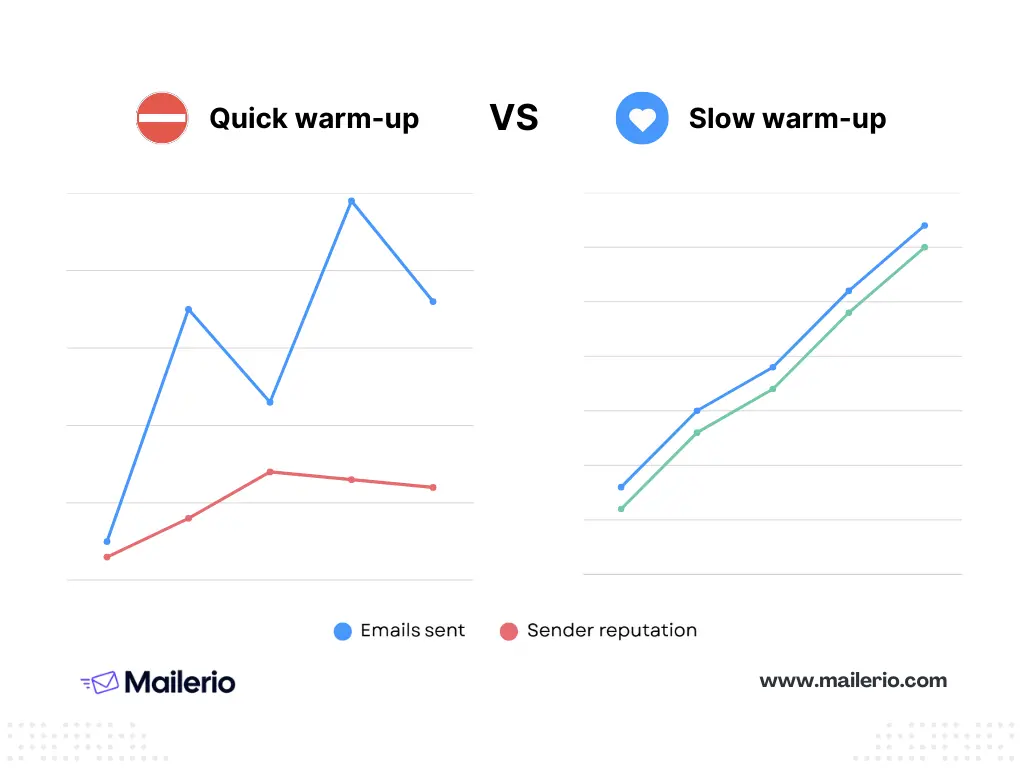

Gradually increase your email volume over a period of weeks. This steady ramp-up allows ISPs to recognize your sending patterns and improve your reputation without triggering spam filters.
Monitor your metrics closely during the warm-up period. Pay attention to open rates, bounce rates, and spam complaints. High engagement signals to ISPs that your emails are valuable, thus enhancing deliverability. This visual perfectly captures the steps you need to take to warm up an IP or a domain.
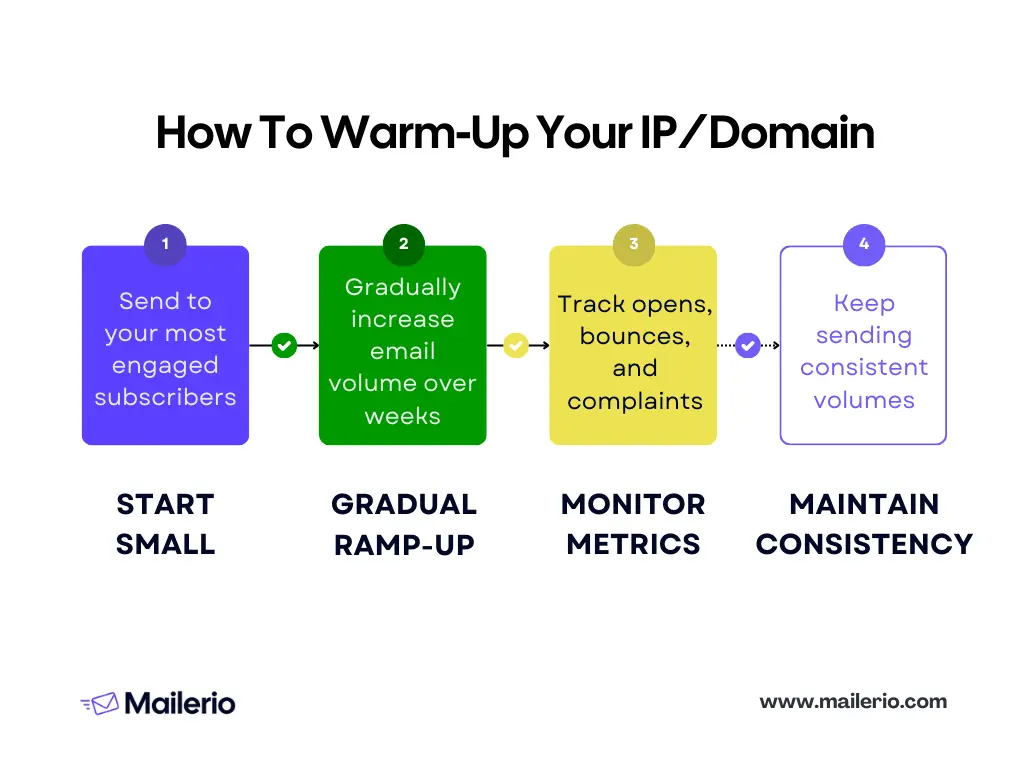

Maintain consistent sending practices once the warm-up phase is complete. Sudden spikes or dips in volume can negatively impact your established reputation.
9. Use Pre-Send Email Deliverability Audits and Testing
Conducting thorough pre-send audits and testing is essential for ensuring your emails reach your audience effectively. Make the most of these practices:
- Check Email Content and Design: Review your email for errors in content, links, and overall design. Ensure it displays correctly across different devices and email clients.
- Test Deliverability: Use tools to send test emails and check their deliverability. Look for any issues that could lead to spam filtering or delivery failures.
- Verify Links and CTAs: Ensure all links and calls-to-action (CTAs) lead to the correct destinations and function as intended. Broken links can frustrate recipients and reduce engagement.
- Assess Load Times: Make sure your email loads quickly. Large images or too many elements can slow it down, leading to a poor user experience.
- Review Personalization and Dynamic Content: Double-check any personalized or dynamic content fields to ensure they pull in the correct data for each recipient.
- Create A/B Tests: Experiment with different subject lines, content variations, or send times to see what resonates best with your audience. This helps you optimize future campaigns for better performance.
10. Protect Data Privacy and Compliance
Stay updated with GDPR, CAN-SPAM, and regional opt-in requirements. Compliance protects your reputation and ensures your emails aren’t penalized by mailbox providers.
- Understand Regulations: Familiarize yourself with relevant regulations such as GDPR, CAN-SPAM, and CCPA. Compliance is not only a legal requirement but also a part of building trust with your audience.
- Obtain Explicit Consent: Always collect email addresses with explicit consent. Use clear and transparent opt in email marketing for deliverability forms to ensure subscribers know what they’re signing up for.
- Implement Secure Data Practices: Safeguard subscriber data with robust security measures. Encrypt sensitive information and regularly update security protocols to prevent breaches.
- Be Transparent in Data Use: Clearly communicate how you collect, store, and use subscriber data in your privacy policy. Transparency builds trust and reassures subscribers.
- Provide Access and Control: Allow subscribers to easily access and manage their information. Offer options to update preferences or delete their data if desired.
- Review Third-Party Compliance: Ensure any third-party services you use also comply with data protection regulations. This includes email service providers and analytics tools.
Trustworthy practices lead to stronger relationships and improved deliverability.
11. Employ Feedback Loops and Monitor Spam Complaints
Feedback loops and monitoring spam complaints are vital for maintaining a strong sender reputation and ensuring your emails reach the inbox. Set up feedback loops with major Internet Service Providers (ISPs) to get these notifications. To quickly identify problematic email addresses or campaign issues and make necessary adjustments.
Spam complaints can negatively impact your sender reputation. Consistently monitoring these complaints is essential. Analyze the complaints to understand why recipients might be marking your emails as spam. It could be due to irrelevant content, too frequent messaging, or unclear unsubscribe options.
Once you’ve identified issues, take proactive steps to address them. Review your email content and sending practices to ensure alignment with subscriber expectations. Implementing changes based on feedback can significantly reduce future complaints.
12. Regularly Run Deliverability Audits
Stick to a consistent audit schedule, be it monthly or quarterly. Routine checks help identify issues early, enabling you to maintain a high inbox placement and reducing spam rates significantly over time.
Start by examining key metrics such as bounce rates, open rates, and spam complaints. These indicators can reveal underlying problems with your email campaigns or list hygiene. Make sure to check Gmail Postmaster tools every once in a while. As this is the place where you can track spam hits, reputation score, and other metrics
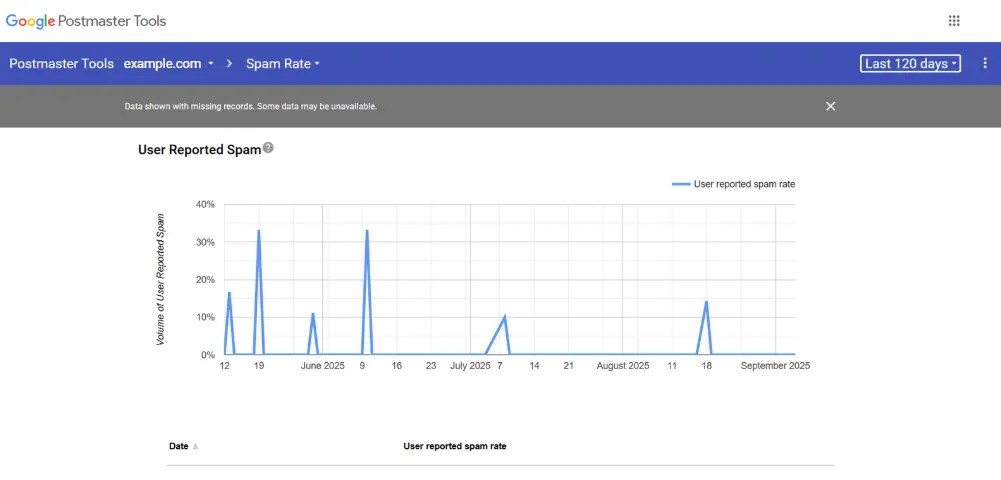

Check your sender reputation using tools that provide insight into how ISPs perceive your sending practices. A poor reputation might signal the need for immediate action to prevent emails from landing in spam folders.
Review your authentication protocols, including SPF, DKIM, and DMARC, to ensure they’re correctly configured and up to date. Misconfigurations can hinder deliverability and damage your reputation.
Test different aspects of your email campaigns, from content to timing, using A/B testing. This helps identify what resonates best with your audience and can improve engagement rates.
Assess and adjust your strategies based on audit findings. Address any issues promptly, whether it’s cleaning up your email list or refining your content strategy.
13. Leverage Automation But Avoid Common Pitfalls
Email automation can enhance efficiency and personalization, but it’s vital to implement it cautiously to avoid common pitfalls. Start by setting clear objectives for your automated campaigns. Whether it’s nurturing leads through outbound or re-engaging inactive subscribers, having well-defined goals ensures your automations serve a purpose.
Personalization is key with automation. Use data to tailor content to each recipient. However, avoid over-personalization that might come off as intrusive. Ensure your data is accurate to prevent embarrassing errors, like incorrect names.
Avoid overwhelming subscribers with too many automated emails. Balance frequency to prevent fatigue, and provide value in every message to keep engagement high.
Keep an eye on performance metrics. Evaluate the effectiveness of your automations regularly, and be prepared to adjust based on what’s working and what isn’t. Automation can streamline processes, but it’s important to pair it with validation methods like Mailerio’s real-time API to prevent fake signups.
How to Check Your Email Deliverability
To effectively assess your email deliverability, you need to track specific metrics that reveal how your campaigns are performing.
- Review Key Email deliverability rates: The first step is to monitor key performance indicators like bounce rates, spam placements, and inbox placement rates. These metrics give you insight into how many emails land in your recipient’s inbox versus being rejected or marked as spam.
- Open Rates: Indicates the percentage of recipients who open your emails. High open rates suggest effective subject lines and a strong reputation.
- Click Rates: Measures how many recipients click on your email links. A good click rate means your content is engaging and relevant.
- Bounce Rates: Reflects undeliverable emails. Keeping this low is essential for maintaining a healthy sender reputation.
- Spam/Junk Rates: High rates here indicate issues with email content or sender reputation.
- Unsubscribe Rates: Indicates how many recipients opt out of your emails. High rates are a red flag for relevance and frequency.
- Domain/IP Reputation: Your reputation impacts deliverability. Monitoring it helps maintain consistent inbox placement.
- Inbox Placement Rate: Shows the percentage of emails reaching the inbox versus spam or junk folders.
- Deliverability Rate: Combines all metrics to show overall success in reaching your audience.
- Set Up a Workflow: Establish a process for regular checks. Create a workflow or use a chart that includes monitoring tools, metrics to review, and a schedule for audits. Consistent evaluation helps you quickly identify and resolve issues.
- Use Recommended Tools: Leverage tools to streamline the process. Mailerio can be invaluable for email validation. It helps ensure your list remains clean and that emails reach their destination.
- Benchmark Against Industry Averages: Compare your results with industry standards to evaluate your performance. Hard-bounce rates typically hover around 2%, while spam-folder placements for well-maintained lists range between 1-5%. This comparison can highlight areas needing improvement.
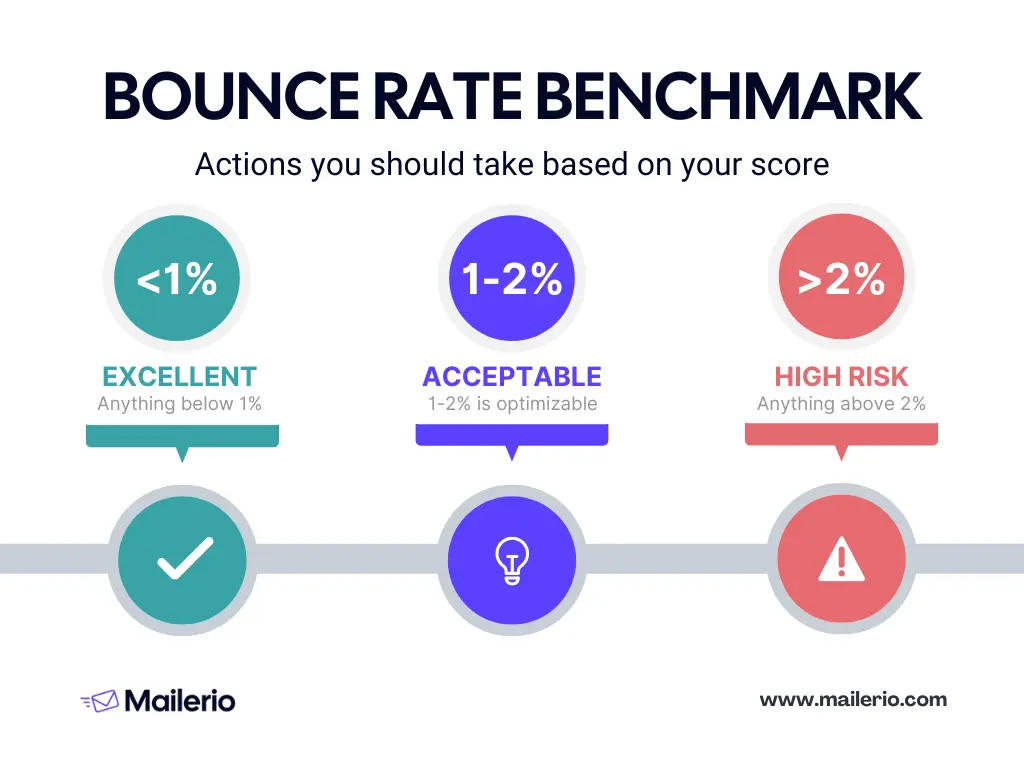

By following these steps, you’ll gain a clearer picture of your email deliverability and can take proactive steps to improve it.
Notably, industry data highlights that companies that systematically clean and validate lists see 20–30% higher engagement rates and above-average inbox placement, according to Gartner. This emphasizes the importance of regular list hygiene to boost marketing success.
How to Conduct an Email Deliverability Audit (Step-by-Step)
Conducting regular email deliverability audits is crucial to ensure that your emails reach the inbox.
Monthly/Quarterly Review Checklist
- Authentication Checks: Verify SPF, DKIM, and DMARC setups to ensure they are correctly configured.
- Bounce Rate Analysis: Review bounce back logs and address any patterns of undeliverable emails.
- Engagement Metrics: Evaluate open, click, and unsubscribe rates to gauge user interaction.
- Sender Reputation: Use tools to check your domain and IP reputation for any red flags.
Example Audit Action Plan
- Step 1: Begin by verifying email authentication protocols. Adjust SPF, DKIM, or DMARC settings if needed.
- Step 2: Analyze recent bounce reports to pinpoint problematic addresses. Use this insight to clean up your list.
- Step 3: Assess engagement metrics and create a plan to improve content strategies based on findings.
Integrating Mailerio in Your Workflow
Mailerio can streamline your auditing process by validating email lists and monitoring deliverability. Use Mailerio to conduct real-time email verifications, reducing the chances of bounces and protecting sender reputation.
Troubleshooting Guide: Common Deliverability Problems & Solutions
Encountering deliverability issues can feel frustrating, but with the right approach, you can solve them. Here are common problems and how to tackle them:
Getting Blacklisted: Steps & Recovery
If you find your domain blacklisted, it’s crucial to act fast. First, identify the blacklist your domain is on. Use online tools, like MXtoolbox, to check your domain or IP status.
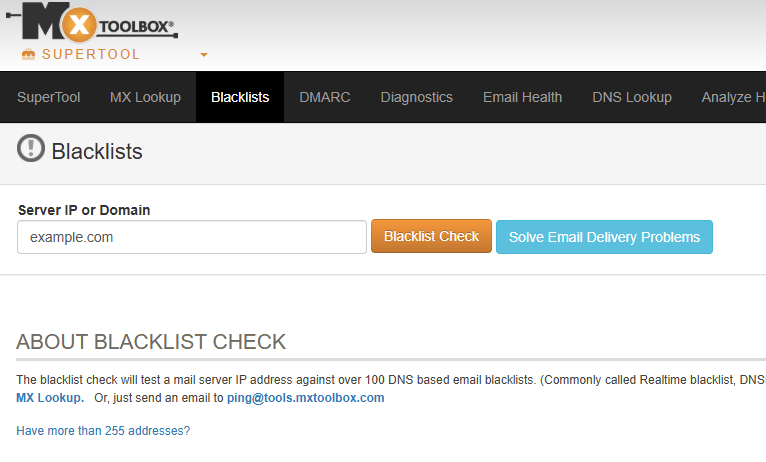

Once identified, reach out to the blacklist provider to understand the reason. Clean up any issues, such as spam complaints or bad data, and request removal.
Low Inbox Placement (Gmail/Outlook/Other)
Gmail and Outlook can have stringent filters. Ensure your emails are authenticated with SPF, DKIM, and DMARC. Focus on email content and engagement rates to improve placement. Monitoring your sender score can offer insights into potential improvement areas.
Spam Folder/Promotions Tab Issues
Landing in the spam or promotions tab instead of the primary inbox can hinder your open rates. Follow email deliverability best practices outlined in this article to maintain healthy engagement. Testing emails before sending them out, using tools that simulate different inbox placements, helps identify issues early or avoid them entirely.
Protect Your Sender Reputation With Mailerio!
Sign Up & Get 100 Credits Upon Registration
Sudden Dips in Send Metrics
A sudden drop in open or click rates can be alarming. Check your email lists for validity and engagement. Ensure your technical setup hasn’t changed unintentionally. Regularly updating your list hygiene practices reduces the chances of such dips.
How to Get Expert Help
When in doubt, seek expert help. Mailerio offers support to help diagnose and resolve deliverability issues. Our team can guide you through tricky configurations and provide strategies for maintaining a good sender reputation.
Real-Life Success Stories: Overcoming Email Deliverability Challenges
For nearly a year, the Mailerio founding team faced one of the most frustrating challenges as a SaaS company: our emails weren’t landing in inboxes for our 1st SaaS, Ajelix. This wasn’t just about poor marketing metrics; it was a barrier to growth.
Our journey began when transactional emails like registration confirmations and password resets didn’t reach our users. Initially dismissed as a technical glitch, it soon impacted our ability to engage and convert users. With alarmingly high bounce rates and deteriorating sender reputation, we realized the issue was more profound than just deliverability, it was endangering our growth.


Despite trying multiple solutions: switching providers, warming up IPs, and setting up authentication, nothing worked. Even reaching out to consultants and sharing our struggles on LinkedIn yielded no specific guidance. Our turning point came when we identified the true problem: invalid and fake email addresses in our database.
We shifted focus to building a tool tailored to our needs: Mailerio. This email validation tool reduced spam complaints by 93%, increased open rates from 20% to 67%, and dramatically dropped our bounce rate to 0.2%. Suddenly, our emails were reaching real inboxes again. Read the full case study here.
Our experience isn’t unique. Many SaaS companies face similar issues due to systemic flaws in handling email as a secondary concern. Recognizing this, we launched Mailerio publicly to help other teams overcome these challenges with a solution rooted in real-world success.
If your emails are landing in spam or if you’re struggling with high bounce rates, consider exploring Mailerio. It’s designed by a team that has navigated this terrain and emerged stronger, turning a challenge into an opportunity for growth. We invite you to be part of this solution and regain control over your email deliverability.
Protect Your Sender Reputation With Mailerio!
Sign Up & Get 100 Credits Upon Registration
Top 8 Email Deliverability Services (Comparison)
Choosing the right email deliverability tool can significantly impact your campaign success. Here’s a look at some of the top contenders, including what they each bring to the table.
Leading Solutions Overview
- Mailerio: Known for high-accuracy email validation and real-time API integration, Mailerio helps maintain stellar deliverability rates.
- Postmark: Focuses on ensuring transactional emails land in the inbox quickly and reliably.
- SendForensics: Provides comprehensive deliverability audits and insights into sending habits.
- GlockApps: Offers inbox placement tests and analytics to optimize deliverability.
Feature Comparison Table
| Service | Features | Pricing Model | Ideal For | Key Benefit |
|---|---|---|---|---|
| Mailerio | Email validation, real-time API | Pay-as-you-go or subscription | SaaS Teams, Marketers | Customizable and cost-effective |
| SendGrid | Email delivery infrastructure | Subscription-based | Large Enterprises | Reliable infrastructure |
| Mailgun | Inbound routing, analytics | Subscription-based | Developers, Enterprises | Comprehensive features |
| SparkPost | Predictive engagement, analytics | Subscription-based | Enterprises | Advanced predictive analytics |
| Postmark | Transactional email focus, real-time delivery | Subscription-based | Startups, Small Businesses | Speedy transactional emails |
| Amazon SES | Bulk email sending | Pay-as-you-go | Cost-Conscious Organizations | Cost-effective, scalable option |
| MailChimp | Marketing automation, A/B testing | Subscription-based | Small to Medium Businesses | User-friendly marketing features |
| Constant Contact | Email marketing, list management | Subscription-based | Small Businesses | Easy-to-use marketing tools |
FAQ
What causes poor email deliverability rates?
Poor deliverability often stems from inadequate list hygiene, missing authentication, and poor reputation management. Data indicates that those in the top tier for hygiene, authentication, and monitoring maintain inbox placement rates of 95% or higher.
How often should you verify your list?
Quarterly list verification is recommended by industry surveys. Staying proactive helps avoid spam complaints, blacklisting, and drops in engagement.
What’s the difference between shared and dedicated IPs for deliverability?
Shared IPs are used by multiple senders, which can affect your reputation based on others’ practices. Dedicated IPs are used solely by you, giving you full control over reputation but requiring more management.
Can I improve deliverability on Gmail/Yahoo with these tips?
Yes, implementing regular list cleaning, proper authentication, and routine audits can improve Gmail/Outlook inbox placement by up to 12 percentage points, as shown in studies.
Are opt-in practices really required for email deliverability?
Yes, opt-in practices ensure your audience genuinely wants your content, which reduces spam complaints and boosts engagement.
How does Mailerio differ from other deliverability tools?
Mailerio excels with its affordable, high-accuracy email validation. It offers easy bulk uploads and real-time API integration, supporting founders and marketers to achieve top-notch deliverability and list quality.
What’s the role of list cleaning during an audit?
List cleaning, supported by tools like Mailerio, is crucial for maintaining low bounce rates and adhering to industry spam benchmarks. It ensures that your emails reach real recipients and keeps your sender reputation strong.
Wrap Up
Consistent audits, a solid technical setup, and active list hygiene aren’t just nice-to-haves; they’re essential for ensuring your emails reach the inbox. Implementing these practices will help increase email deliverability and enable you to achieve your business goals in the long term. As deliverability rates have climbed to over 96%, it’s proof that following best practices makes a difference.
If you’re ready to take your email campaigns to the next level, explore Mailerio’s free credits. Start auditing your lists and see real improvements.
With clear evidence that list hygiene and regular audits boost ROI, now’s the perfect time to sharpen your email strategy. Implement these best practices and watch your deliverability.

